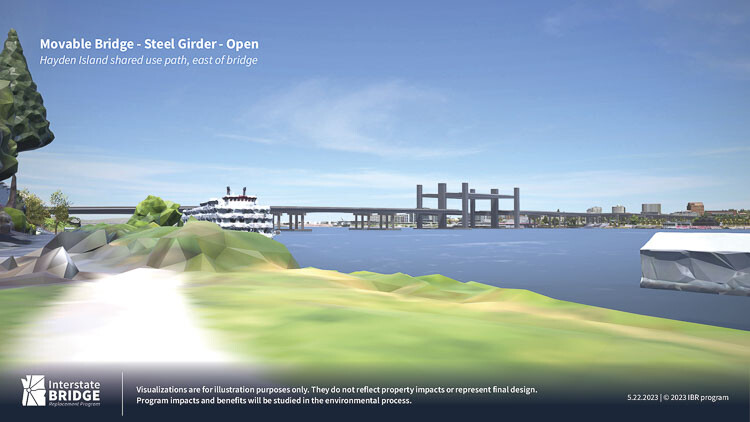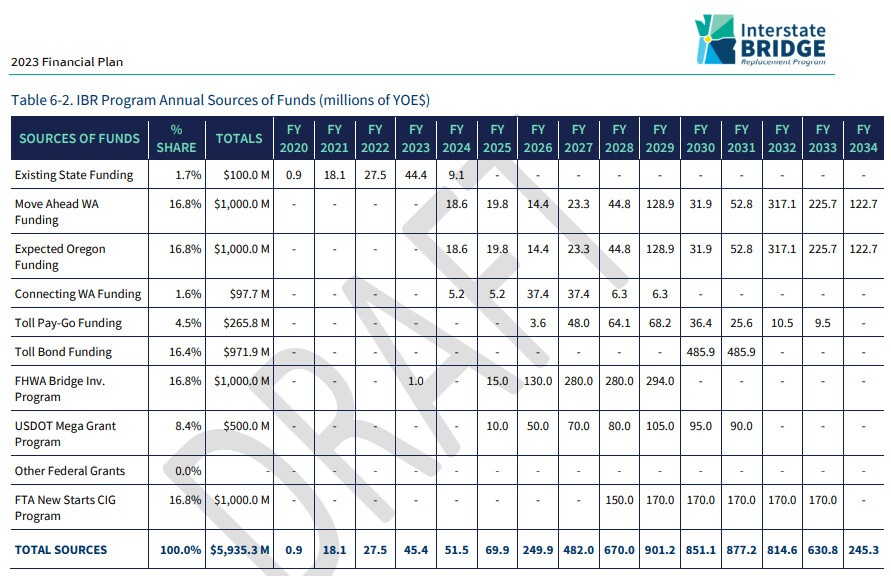Oregon legislature will likely not provide $1 billion this session
John Ley
For Clark County Today
The Interstate Bridge Replacement (IBR) project, as of early June 2023, is a mixed picture of success and challenges ahead. It’s been three and a half years since the two state governors restarted the process. Citizens got their first look at possible “visualizations” of the bridge options last week. Two community forums have been held.
The program successes are getting the Washington legislature to allocate $1.1 billion towards the IBR. A total of $100 million was allocated in the 2015 Connecting Washington gas tax package of projects; and $1 billion allocated in the 2022 Move Ahead Washington package.
A second success has been approval from all the various groups associated with the IBR, to have light rail as the transit component of the project, as opposed to Bus Rapid Transit (BRT) or no “high capacity” transit option. C-TRAN CEO Shawn Donaghy recently told Clark County Today the Federal Transit Administration (FTA) supports BRT “because they typically cost less and provide more flexibility compared to other modes”.The FTA understands light rail is the preferred transit component of the IBR.

A third initial success is getting the federal government and President Biden to agree the IBR is a project of “national significance,” and it is specifically mentioned in the $1.2 trillion IIJA (Infrastructure Investment and Jobs Act). However other national projects have been funded ahead of the IBR as they await a “contribution” from Oregon.
Current challenges for the IBR are many. At the top of the list – Oregon is facing huge obstacles in providing its $1 billion in funding the project. States must provide the “local” funding prior to the federal government committing funds. Oregon Gov. Tina Kotek rejected an initial proposal from some legislators who wanted to bond against future general fund revenues for the next decade.
An additional significant problem is the Oregon Senate does not have a quorum to pass any legislation. Over 10 Republican and one independent senators have walked out preventing the ability of the Democrat majority to pass any legislation in the Senate. The current session ends June 25. Republicans have said they will come back on June 25, presumably to pass a budget to keep the Oregon government running. But it is problematic that they would be able to reach an agreement on a transportation package.
The March 2023 Oregon Transportation Plan (OTP) indicates the state has a huge backlog of work just to maintain their current system of roads and bridges. This is in addition to a roughly $2 billion funding shortfall for current projects, including the I-5 Rose Quarter and I-205 Abernethy Bridge projects.
“Under current funding levels, System Preservation and Adaptation investments fall further behind in addressing the needs of the current system”, the OTP reported. It also states: “nearly 300 bridges are likely to be weight restricted, with a $7 billion backlog in bridge maintenance and $4 billion backlog in pavement preservation.”
A second significant obstacle relates to tolling. Oregonians, and particularly Clackamas County residents are outraged at ODOT’s plan to toll I-205. There will be double tolls – one for crossing the Abernethy Bridge and then the Tualatin River bridge on I-205; plus an additional “per mile” toll for driving a significant length of I-205 as part of their Regional Mobility Pricing Program (MPP).
The tolling will cause significant traffic diversion onto side roads that are already congested with vehicles due to an overall lack of vehicle capacity in the region. Every community along the southeast part of I-205 is against the tolling because of the impact of traffic diversion. In many cases, tens of thousands of additional vehicle trips will congest side roads and arterials in Oregon City, Gladstone, West Linn, Canby, Tualatin, and Lake Oswego.
Numerous Oregon legislators have introduced legislation prohibiting tolling on I-205. Governor Kotek issued an Executive Order prohibiting ODOT from placing tolls on I-205 until January 2026, an estimated 18-month delay. This reduces the availability of “preconstruction” funds available for the Abernethy Bridge and I-205 expansion project.

At the June Regional Transportation Council (RTC) Board meetings, WSDOT’s Carly Francis told the board the Oregon governor’s order was only a “pause on toll collection”. The back office development by the IBR team continues.to including tolling. The IBR toll collection is planned for mid 2026 according to Francis.
Additionally, citizens have introduced IP-4 which will require a vote before a toll can be placed on any Oregon highway or freeway. This includes the Interstate Bridge. (Oregon currently has one of 17 exemptions to federal law which prohibits tolling on interstate freeways). The supporters of IP-4 need 200,000 signatures of registered Oregon voters in order to put the initiative on the November 2024 ballot.
If IP-4 becomes law, it eliminates potentially $1.24 billion in money the IBR hopes to borrow for the project, paid back by tolling revenues.
A third major obstacle for the IBR is the US Coast Guard and Army Corps of Engineers. They must grant approval of the project. At present, the Coast Guard has rejected an IBR request for a bridge with 116 feet of clearance for marine traffic. In the spring of 2022, it demanded any project provide at least the current 178 feet of clearance. In 2023, they reemphasized that demand and said they prefer a project with “unlimited” clearance for Columbia River marine traffic.
At the RTC meeting, Councilor Gary Medivy (RTC Board Chair) asked for an explanation, as the Coast Guard wants higher and the IBR “didn’t deliver.” Francis answered saying there was a “preliminary analysis” done and the conversation continues with upriver firms to see “if they can manage their needs over time” to accept a lower bridge. Medvigy noted that the previous effort required a significant payment to these firms.
The IBR is presently hoping to negotiate with river users, hoping to find a way to “mitigate” their opposition to the current proposal, which the Coast Guard might approve. In the failed Columbia River Crossing (CRC), the project was going to pay three upriver firms $86.4 million. That figure would be in excess of $114 million today. The IBR has demanded the firms sign non-disclosure agreements to keep current discussions secret.
The Nov. 2022 IBR Bridge Clearance Assessment Report indicates a 116 foot bridge with a movable span would require (at present) 85 openings per year.
Construction and tolling would begin in 2026, provided Oregon provides funding, the Federal Highway Administration provides an estimated $1.5 billion in funding for the roads and the bridges; and the FTA provides nearly $1 billion for light rail. But the biggest obstacle may be the Coast Guard and Army Corps of Engineers.
Also read:
- Busy pavement season ahead on Vancouver streetsThe city of Vancouver is set to repave and preserve 76 lane miles across 20 neighborhoods in summer 2025, with ADA upgrades and community notices throughout.
- State representative: Expect sticker shock when Interstate Bridge project officials reveal price, tolling plansAt a town hall in Battle Ground, Rep. John Ley warned of major cost increases and tolling burdens tied to the Interstate Bridge replacement project.
- Opinion: Washington state lawmakers increase the cost of driving – againBob Pishue of Mountain States Policy Center argues that new vehicle and fuel taxes in Washington will raise driving costs while diverting funds away from roads.
- Overnight full closure of I-5 near Woodland for bridge inspection, May 6WSDOT will fully close southbound I-5 near Woodland overnight on Tuesday, May 6 for a bridge inspection using a chain drag test.
- Opinion: Do we still need TriMet?John A. Charles Jr. of the Cascade Policy Institute argues that TriMet should halt expansion plans and prepare for major service reductions in response to falling ridership and rising costs.










Buses or vans can be sized to meet changing demand, share a lane with other vehicles, and maximize limited transportation real estate and funds. Light rail runs on expensive fixed tracks on the ground that are sometimes flooded by rain. Electrified cables above overheat in summer, and freeze in winter, stopping the trains. Buses are then called to rescue light rail passengers.
When the Oregon Columbia River Crossing oversight committee met in Oregon in 2011, they asked about the bus alternative instead of light rail.
“CRC Deputy Director Kris Strickler said cost was a driving force behind presenting five different alternatives in the DEIS, some of which offered bus rapid transit instead of light rail.
“At that time, cost was a factor,” Strickler said. “It was a driver in the discussion.”
And cost is not a factor now?
For all the $ BILLIONS planned to replace a functioning bridge, the viable proposals to reduce bridge lifts today for a small amount should not be ignored as they have been for decades..
1 Stop allowing personal on demand bridge lifts for recreational vessels like huge sailboats starting at 6 pm weekdays.
2- Eliminate the only HOV lane in OR, just before the bridge on I-5 heading North. Share all lanes with all users, like is done on the WA side of I-5 South.
3- Align the railroad bridge lift with the high point on the current I-5 bridge, which is estimated to eliminate over 90% of bridge lifts.
If WA and OR can fund a bridge in the future, a new bridge on the west side of the Ii5 Bridge to create a needed travel corridor would cut down traffic on the I-5 bridge, and better serve transport of goods, services, and people in the region.
See https://www.clarkcountytoday.com/opinion/opinion-replacing-the-i-5-bridge-is-not-a-solution-for-anything/
While a new bridge would improve traffic flow across the Columbia River, I couldn’t possibly accept a bridge with trolly cars. Extension of the Portland “light rail” into Washington is simply a way to collect more funds for an extremely expensive trolly system. The “Red” line that would be extended is far from “rapid transit” (Indeed, the Bus Rapid Transit would move far faster) and would likely not generate anywhere near the number of riders as projected. (On average “light rail” projects cost twice the estimates and generate half the passengers than projected before the project is constructed.)
I would suggest that which ever bridge plan that is selected, that it should be one that has no “surrounding structure” — as the current bridge. (This would eliminate the double deck design.) When drivers approach an (seemingly) enclosed structure (bridge or tunnel) there is an unconscious tendency to slow down as the structure is approached — this generates a traffic back-up near the threshold of the structure — and in heavy traffic this can lead to a substantial traffic jam, extending as much as two miles before the structure. This is made worse by the on flow of traffic entering the structure from connecting roads (such as WA 14 (southbound) or the onramps on the Oregon side (northbound).) Open construction, such as the I-205 bridge, do not have this artifact of human psychology.